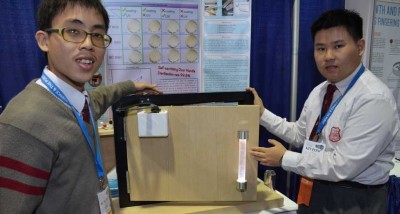New Door Handle Kills Germs on Contact!
HEALTH, 29 Jun 2015
John Vibes, True Activist – TRANSCEND Media Service
26 Jun 2015 – Two teenage science students from Hong Kong recently won second place at the Intel International Science and Engineering Fair for their new invention, a door handle that kills germs on contact.
Door handles are one of the most common causes of the spreading of sicknesses because they are touched commonly by so many people throughout the day. Elevator buttons, stair handles, and other surfaces are also high traffic areas that tend to collect a lot of germs, and this same process can be applied to these same surfaces as well.
Hong Kong students Sum Ming Wong and Kin Pong Li have luckily come up with a solution for this problem. Knowing that certain minerals kill germs on contact, the students decided to research which minerals would be the best choices. They decided on using titanium dioxide to coat the door handle and installed a UV light as well, to provide additional sanitization.
The UV light doesn’t even require any electricity; the unit is installed with a box that captures energy from the door opening and closing, allowing the light to shine without a power source.
Tests found that the door handle was 99.8 percent effective at killing germs.
______________________________
This article is free and open source. You have permission to republish it under a Creative Commons license with attribution to the author and TrueActivist.com.
Go to Original – trueactivist.com
DISCLAIMER: The statements, views and opinions expressed in pieces republished here are solely those of the authors and do not necessarily represent those of TMS. In accordance with title 17 U.S.C. section 107, this material is distributed without profit to those who have expressed a prior interest in receiving the included information for research and educational purposes. TMS has no affiliation whatsoever with the originator of this article nor is TMS endorsed or sponsored by the originator. “GO TO ORIGINAL” links are provided as a convenience to our readers and allow for verification of authenticity. However, as originating pages are often updated by their originating host sites, the versions posted may not match the versions our readers view when clicking the “GO TO ORIGINAL” links. This site contains copyrighted material the use of which has not always been specifically authorized by the copyright owner. We are making such material available in our efforts to advance understanding of environmental, political, human rights, economic, democracy, scientific, and social justice issues, etc. We believe this constitutes a ‘fair use’ of any such copyrighted material as provided for in section 107 of the US Copyright Law. In accordance with Title 17 U.S.C. Section 107, the material on this site is distributed without profit to those who have expressed a prior interest in receiving the included information for research and educational purposes. For more information go to: http://www.law.cornell.edu/uscode/17/107.shtml. If you wish to use copyrighted material from this site for purposes of your own that go beyond ‘fair use’, you must obtain permission from the copyright owner.
